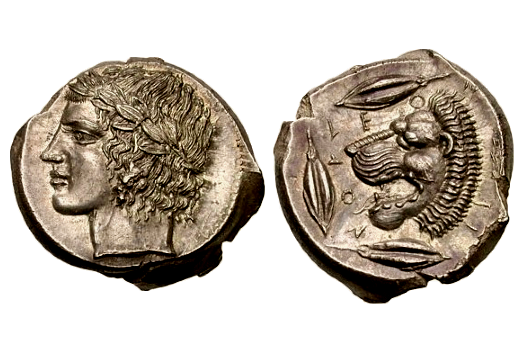
about ancient nomos
Ancient Nomos Art is a museum of galleries exhibiting ancient coins and ancient mint maps. The coin gallery displays the diverse art and history of hand-crafted ancient Greek, Roman, Byzantine, Persian and Medieval coinage. The ancient mints mapping gallery features Greek, Roman, Byzantine, Asia Minor and Medieval mint city regions and territories. Visitor's are welcome to explore, study and enjoy Ancient Nomos Art.

Greek, Leontini – 430 BC
Leontini
From Ancient Galleries

Obverse: Youthful bust of Apollo facing left, wearing a laurel wreath.
Reverse: Head of Lion facing right, three barley grains and one leaf in fields around.
LEGEND SYMBOLS
Obv: Head of Apollo facing left, wearing laurel wreath. Rev: Head of roaring lion facing right; legend: LE-O-N-TI-N-ON around; in the fields are three barley grains above, to the left, and below; a single leaf is behind.
The ancient Magna-Graecia is located just north of Syracuse about twenty miles and is thought to have been colonized by Greek settlers from the Chalcidian Peninsula of Naxos toward the end of the eighth century BC. It was an inland city-state, situated 20 miles northwest of Syracuse on the island of Sicily. This earliest known coinage of Leontini were pre-classical style tetradrachms struck between 500 – 466 BC, on the ancient Greek Attic weight standard. Fortunately, after Leontini suffered a tragic loss of independence under the reigns of the tyrant Gelon and later under Hieron, she was able to regain its independence in 466 BC. The region of Leontini, like other Magna-Graecia Greek city states, enjoyed a period of prosperity for the next half century. Under the reign of Gelon, the obverse tetradrachm types depicted the mythic tale of Nike flying over the charging quadriga of horses, a similar type as minted in Gela and Syracuse. Shortly after regaining its independence, Leontini abandoned the quadriga type tetradrachms, choosing instead to issue its own spectacular new Apollo type coinage featuring the youthful visage of this ancient Greek sun deity, facing left. Between 466 and 422 BC the engraved obverse designs depict an ever increasingly refined classical portrait of a youthful God Apollo. In fact, these coin dies were thought to have been individually engraved by an exceptionally gifted and known artist termed, after Rizzo, the “maestro della foglia“ noted by the one leaf that appears as part of the design. He was an exquisite engraver and brilliant artist that worked at Leontini and at Katane. The equally quintessential Leontini reverse design type is of a large roaring Lion’s head with open jaws, extended tongue and large mane. The Lion is surrounded by three grains and one leaf, in total representing the four-denomination value of a tetradrachm. This is a similar depiction of four “value” images in a ring of four dolphins surrounding the tetradrachms of Syracuse. The ethnic “LEONTINON” can be found clockwise around the lion’s head beginning at 10 o’clock. The choice of Apollo for the obverse reflects the reverence with which Apollo was worshipped at Leontini, while the lion, Apollo’s emblem, is also likely to be a pun alluding to the city-state’s namesake. In 427 BC Leontini became embroiled After a five-year struggle with its powerful neighbor Syracuse, Leontini lost its state of independence in 422 BC and no longer issued this wonderous coin.
DOCUMENTATION
Value: Tetradrachm. Metal: AR Silver. Weight: 17.46 grams. Mint: Sicily, Leontini. Date: 430-425 BC.
Attribution: Boehringer, Münzgeschichte 55 (same dies); HGC 2, 671 (same dies as illustration); SNG ANS 257 (same dies); SNG Lloyd 1063 (same obverse die); Basel 353 (same dies); Rizzo, Rome 1946, plate XXIV, 4 (same dies).
Legend, Documentation and Attribution
